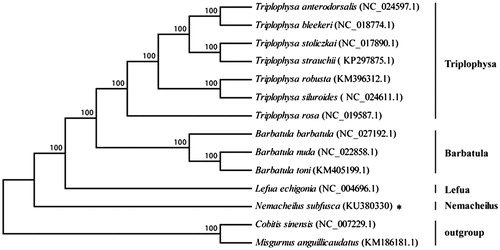Abstract
The Nemacheilus subfusca (N. subfusca) is a species of the Noemacheilinae in the Cobitidae family, which has been few reported. The first complete mitochondrion of the N. subfusca is 16 585 bp in length, containing 13 protein-coding genes, two rRNA genes (12S and 16S rRNA), 22 tRNA genes and a control region (D-loop region). The longest protein-coding gene of this mitochondrion was ND5 (1839 bp), and the 22 tRNA genes were range from 66 (tRNACys) to 76 (tRNALys) in length. The 12S rRNA (957 bp) and 16S rRNA (1677 bp) were separated by TrnaVal, and the D-loop region located between tRNAPro and tRNAPhe genes. The phylogenetic indicates that the N. subfusca was independent from other species of distinct genus in the Noemacheilinae, which provided the valuable evidence on phylogenetic relationship of the N. subfusca at the molecular level.
The Cypriniformes is the largest freshwater fish group in the world and had 2662 species in 1994 (Nelson Citation2006). As one family of Cypriniformes, the Cobitidae (23 genus and 200 species) have great morphological differences among numerous species, and distributed in Eurasia and nearby and parts of Africa (Sawada Citation1982). The Nemacheilus subfusca (Cypriniformes: Cobitidae) was found in Brahmaputra River in Tibet and India, and inhabited between the gravels and bank of rivers(Froese & Pauly Citation2000; Roskov et al. Citation2013). The sample and information resource of the N. subfusca are rare, and the taxonomic relation between N. subfusca and other species of the Cobitidae remains unknown. Identification of complete mitogenome of the N. subfusca would supplement the limited data on molecular level and be reference for systematics.
The N. subfusca was obtained from lower reach of Yarlung Zangbo River (Motuo, Tibet), and the fin was separated as a sample. The genomic DNA was extracted by the DNeasy Tissue Kit (Qiagen, Hilden, Germany), following the standard procedure. The complete mitochondrion sequence was amplified by PCR with distinct primers and assembled by DNAstar v7.1 (DNASTAR, Inc., Madison, WI). In general, the length of this sequence is 16 585 bp (GenBank accession no. KU380330), containing 13 protein-coding genes, two rRNA genes (12S and 16S rRNA), 22 tRNA genes and a control region (D-loop region), consisting of other mammals (Curole & Kocher Citation1999).
Among the protein-coding genes, 11 genes took the start codon of ATG, while COX1 and ND6 got GTG and CTA, respectively. The termination codon of these protein-coding genes had four types (six genes were TAA, three genes were TAG, three genes were “T– –” and one gene was CAT). The longest gene in this mitochondrion was ND5 (1839 bp), and the 22 tRNA genes were range from 66 (tRNACys) to 76 (tRNALys) in length. The 12S rRNA (957 bp) and 16S rRNA (1677 bp) were separated by TrnaVal gene, and the D-loop region located between tRNAPro and tRNAPhe genes, with the length of 928 bp. Furthermore, three overlaps between protein-coding genes were found, including the ATP6 and ATP8 genes with 10 bp, ND4L and ND4 genes with 7 bp, ND5 and ND6 genes with 4 bp, which consisted of Beaufortia szechuanensis (Wu et al. Citation2015).
The Cobitidae, one group of the Cobitoidea, had three subfamilies (Botiinae, Cobitidinae and Noemacheilinae). To explore the phylogenetic position and relationship of the N. subfusca among other species of the Noemacheilinae, the complete mitochondrion sequences of 11 species of three genus from the Noemacheilinae and the complete mitochondrion sequence of the N. subfusca in this study were used to construct the phylogenetic tree by MEGA6.06 software (MEGA Brands Inc., Montreal, QC) with ML analysis, and took the Cobitis sinensis and misgurnus anguillicaudatus as the outgroup (). The neighbour-joining (NJ) tree (with 1000 bootstrap replicates) and the perfect bootstrap of each cluster verified that the N. subfusca was independent from Triplophysa (Triplophysa anterodorsalis, Triplophysa bleekeri, Triplophysa stoliczkai, Triplophysa strauchii, Triplophysa robusta, Triplophysa siluroides and Triplophysa rosa), Barbatula (Barbatula barbatula, Barbatula nuda and Barbatula toni) and Lefua (Lefua echigonia). This result provided the valuable evidence on phylogenetic relationship of the N. subfusca at the molecular level.
Disclosure statement
The authors report no conflict of interest. The authors alone are responsible for the content and writing of the article. The research is supported by Special Fund for Agro-Scientific Research in the Public Interest (201403012).
References
- Curole JP, Kocher TD. 1999. Mitogenomics: digging deeper with complete mitochondrial genomes. Trends Ecol Evol. (Amst.) 14:394–398.
- Froese R, Pauly D. 2000. Fishbase: a global information system on fishes. New York: FishBase.
- Nelson JS. 2006. Fishes of the world. New York (NY): John Wiley & Sons.
- Roskov Y, Kunze T, Paglinawan L, Orrell T, Nicolson D, Culham A, Bailly N, Kirk P, Bourgoin T, Baillargeon G. 2013. Species 2000 & ITIS Catalogue of Life. 2013 Annual Checklist.
- Sawada Y. 1982. Phylogeny and zoogeography of the superfamily Cobitoidea (Cyprinoidei, Cypriniformes). Mem Faculty Fish Hokkaido Univ. 28:65–223.
- Wu J, He Y, Ren H, Zhang Y, Du Z, Xie M, Zhu G, Wang Q, Jiang Y, He T. 2015. The complete mitochondrial genome sequence of Beaufortia szechuanensis (Cypriniformes, Balitoridae). Mitochondrial DNA. 2015:1–2.

